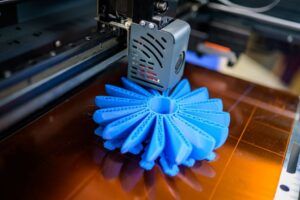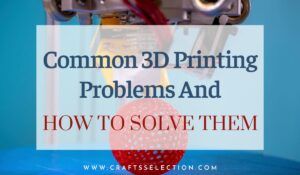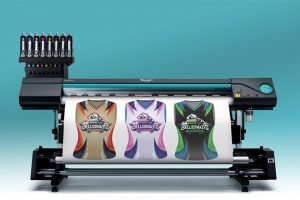The key to going from an amateur to a professional in 3D printing is to keep on doing projects. And the only way for that is to look for new and exciting 3D printing projects at home. Something that you can enjoy with your kids and build using easily available materials.
You could either try your hand at creating some toys indigenous for your kids or build something funky for your work desk. Or maybe your kids have some great ideas! Whatever may be your aspiration, the following 3D printing ideas for beginners will help you find the inspiration for your next project.
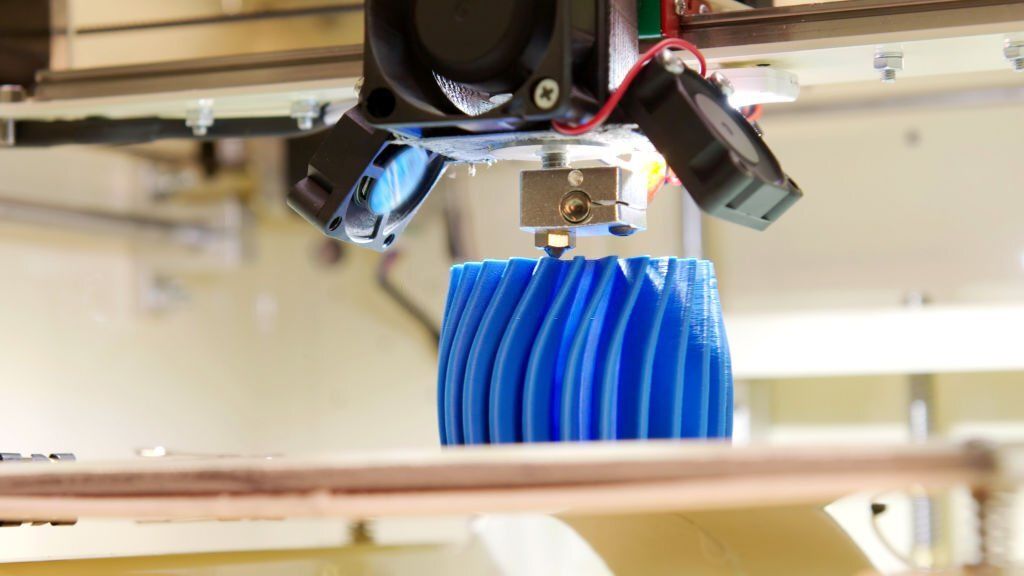
What Can I Do With a 3D Printer?
A good 3D printer is an essential tool in a modern home today. It equips the household to build objects out of imagination or need. With a 3D printer, you can fix a broken curtain bracket as well as build a DIY mobile stand for your school-going kid.
It’s like an on-demand printing machine that can be fed with the required materials to also produce anything that is otherwise difficult to procure. A friend of ours recently 3D printed a small screw for her furniture after the furniture manufacturer quoted $80 for a replacement. Imagine that!
Bought a pricey gadget from an international ecommerce website that has a broken cab or a nozzle? Fire up your desktop 3D printer and get started.
The benefits of having a 3D printer at home are countless. We have listed down some of the most obvious in the sections below.
Benefits of a 3D Printer at Home
- Flexibility in design – Build any object or replacement for a home appliance with any material and using any specification
- 3D print on demand – Print as per your wants and needs
- Wide range of materials – 3D printing offers experimentation to DIYers as it allows printing with a variety of materials such as plastic, polymers, and resins
- Quick designing and printing – Modern 3D printers are fast and efficient. Objects can be printed in a matter of minutes to a few hours
- Waste control – Print using sufficient materials to avoid wastage (which is a disadvantage in mass production)
- Easy to use – Kids with parental guidance can get started on 3D printing at a young age
- Cheap – Cost-effective and customized home production for simple items such as corks, spoons, Lego parts
- Ease of access – 3D printers and printing materials are easily available off the shelf and online
These benefits highlight a tranche of applications that you can try at home. Here’s a list of home 3D printing applications for DIYers and casual users.
Applications of a Home 3D Printer: Various Fields
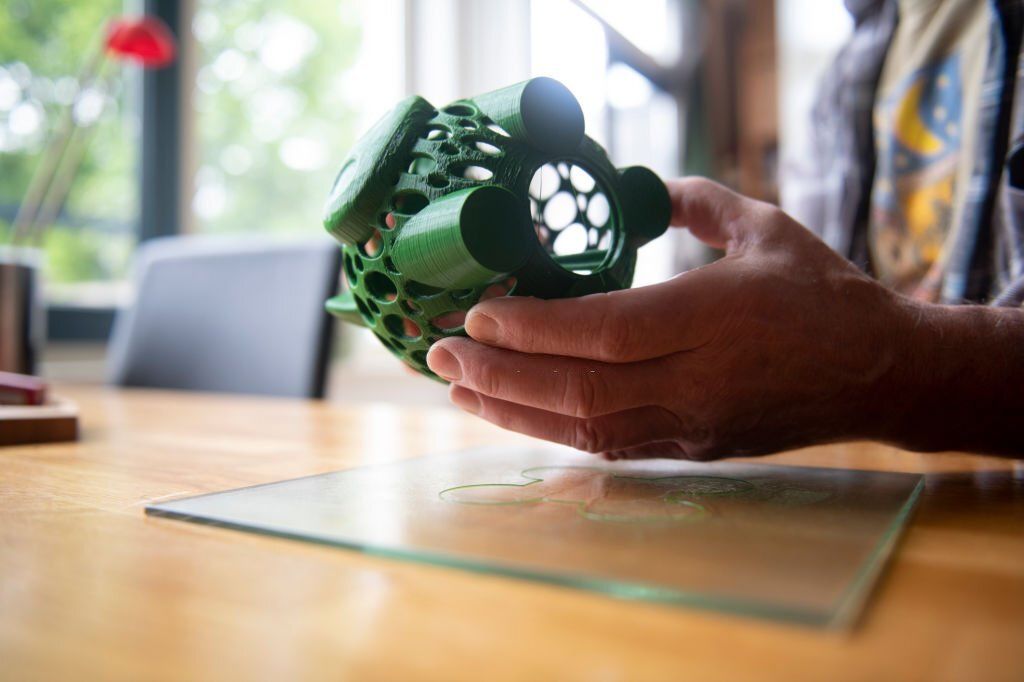

3D printing can have applications in virtually any field or sector.
Take education, for example. With a 3D printer, you can build permanent plastic flash cards for a kindergarten class. This way, you can customize the cards and add your own imagination and designs to them. The same applies to other fields such as the following:
- Decoration – show pieces, panels, carvings
- Homeschooling – customized tiffin/pencil box, pencil holder, Lego bricks
- Home Improvement – tool parts, tiny replacements, holders, frying pan handle
- Interior Designing – panels, frames, décor balls, confetti
- Arts and Crafts – customized mugs, photo frame embellishments
- Small Business – print-on-demand products, phone covers
- Miscellaneous – tube caps, charger connectors
In that regard, here are some of the most common uses of a home 3D printer that will make the purchase worthwhile:
- Fix household items and appliances by 3D printing broken parts
- Experiment by inventing cool new products like an “earphone cable untangler”
- Print small and medium parts and products that are useful in the kitchen
- Replace broken tiny items like customized screws and parts for your furniture (e.g.: an IKEA screw for your Billy or Nodeland bookshelf)
- Improve an existing design by tinkering with it digitally and then 3D printing the output
3D Printing Projects to Try at Home
When you have a new 3D printer for home use, your creative juices tend to flow automatically. Make good use of that creativity and pick one of these great 3d printing projects to try at home for kids and DIYers to get started.
1. Mobile or Tablet Stand
Virtual classrooms are here to stay, regardless of the back-to-school mandates that have been activated around the world in the face of an ebbing coronavirus pandemic. That gives the right opportunity to experiment with a customized stand for your kid’s designated mobile or tablet.
Do you usually place your phone or tablet leaning on another object during online classes? If yes, then you definitely need to try this.
The premise is simple: a sturdy base with a slanting frame that can hold your phone in either portrait or landscape mode. Make sure you leave some cavity for the charger cable and its connector to fit through because no video class or online class ever ended without the need for extra charge. Right?
Design: Check out this stand at Thingiverse.
2. Self-Watering Planter (Home Plant Pot)
Another cool 3D print design that can be executed using PLA material is a self-watering planter. If you’re someone like me who took to gardening during the pandemic, this will be a great project for you.
The concept is simple: there are two bowls, one of which holds the soil and the plant, and the other acts as a water reservoir. The self-watering action kicks in when the plant needs water as the plant’s bowl slides into the larger bowl. Of course, you’ll need to fill up the reservoir periodically but you don’t have to do it every day. That removes one chore from your daily schedule!
Do you sometimes forget to water your plants and then feel bad looking at that sole plant that’s frail now? Try this one today.
Design: Check out the instructions at Thingiverse.
3. Lego Brick Separator


If there’s one gripe I have with the Lego makers then it is that they only send in one separator or remover with every pack. When I’m building stuff using Lego with my kids, it would make it easier if each of us had a separator of our own. And that’s exactly what I mean when I say a 3D printer is a modern home essential. You can create your own separator and it won’t even take much effort.
Since the separator design is already available (paid version), you can easily build a replica with a stronger material. Just use PLA or HIPS or even plastic composite to produce a stronger Lego brick separator for everyone.
This applies to other games and home activities as well. You can also try an Uno card holder/dispenser, Monopoly money box, and many more depending upon the indoor games you play with your kids. Just remember that if you can imagine it, you can 3D print it.
4. Cable Holder
The digital lives that we live today may have a lot of pros and cons. But one thing that definitely sticks out as a con is the sheer number of cables we have to handle. There’s one or more for the mobile, the laptops, the iPads, the electric toothbrush, the water flosser, the trimmer, the hair blower, and the wireless speaker. The list goes on and on.
The scene is even more drastic at a work desk. A collection of cables and wires that take up a large real estate of your desk, hindering your work and making things disappear suddenly. Where did I place my pen?!
A good solution for this is to experiment with a cable holder. It’s simple to make and does not require a lot of prototyping or iterations. A minimalistic version would include a circular ring made of synthetic rubber with a small opening for the wires and cables to slide in.
If you’re feeling creative, you can also attach a tail to it so that you can affix the holder to a corner of your desk.
5. Hooks, Hangers, Etc.
Home improvement is another area where a 3D printer can greatly help.
Did the hook frame of your wardrobe recently come off? With a desktop 3D printer, you can easily print individual hooks and fix them onto the frame. And not just your wardrobe, you can fix, improve, and add tiny things like hooks, frames, lines, cuts, and hangers to literally any furniture or fittings in your house.
There is no longer a need to run to the hardware store or call up the repair guy. You can also 3D print your own attachments and components instead of buying them off the shelf, especially if you are not satisfied with the mass market designs. It could be a thing as common as a hinge, a plug, or an earphone pin cover.
6. Protective Covers
Back in the day, one piece of advice that my parents used to give me was to overprotect my stuff immediately after buying them. An example of this is re-sewing my brand-new schoolbag before using it for the first time just to reinforce its original stitch. And it worked.
The same is the idea with everyday objects that we use today. A common one being power chargers. This is an extension of the idea of printing an earphone pin cover.
How many times have you had a fraying charger cable that’s almost on the verge of being separated from its connector? If the answer is in multiples, you need to start making polymer covers for them ASAP.
The concept is simple: create glove-like sleeves for your charger connectors so that the plastic original covers do not fray easily due to wear and tear. And even if they do, the cover protects the metal bearings and extends their longevity. Just make sure they fit snugly.
7. Coaster
A fun 3D printing activity that you can do with your kids is to create coasters for your dining or coffee table. They are flat objects that protect the table from greasing or spotting. Because they are square and flat, they are easier to design and print. You also don’t need complex materials to build. Simply use PLA or ABS to get it done.
Along with coasters, you can also build similar flat objects for your kids’ play area. A great idea is to build a large rubber mat which can hold all the toys and their tiny parts. Make it off-white and bright so that all the toys stay in the same place (visibly) while playing and you don’t have to go on a treasure hunt to find them later.
8. Whistle
Kids love objects that deal with the sensory response. And what better way to take advantage of this than making a handy whistle? Something that you and your kids can keep in your person and use for secret communication.
Although a whistle has an enclosed structure, it’s easier to make using any entry-level 3D printer and OTC materials like HIPS. We recommend HIPS or TPE as it’s safer than PLA and you can use it on your mouth without any fear of contamination.
9. Story or Movie Character
/https://files.cults3d.com/uploaders/15075638/illustration-file/14ffe669-a1ef-4924-99f4-c15b203eb234/Tails_STL.png)
/https://files.cults3d.com/uploaders/15075638/illustration-file/14ffe669-a1ef-4924-99f4-c15b203eb234/Tails_STL.png)
If your kids are a fan of a particular movie, story, or video game character, you can try 3D printing it and using it as a figurine or a key chain. The advantage of such a project is that the designs will already be available online for a variety of popular characters. (Here are some free and kids-safe 3D print designs from Cults).
You can also try a 2D version and combine it with our coaster idea. Having the image of Mario on your kid’s personal coaster can not only make for an interesting 3D printing project but also cultivate the habit of hygiene and tidiness in your child.
10. Spoon or Cutlery
Most children younger than five tend to have erratic eating habits. You want your kids to eat okra but the moment they see it on the plate, they run away. Do you experience something similar in your house?
Then building a food-safe spoon using a good 3D printer could probably solve that issue. When it comes to eating habits, kids generally show aversion to the act of eating than the food or its taste itself. So, when you build a spoon that’s dedicated to them, they will be more likely to finish their plate.
Of course, this may be short-lived, but 3D printing a spoon every now and then with their favorite shapes and figures on the handle could just be a continuous activity that keeps your kid occupied and ensures that your 3D printer keeps running too.
Conclusion
We were careful in picking these beginner projects for at-home 3D printers so that you could pull them off with the basic materials. All of them require you to spend a matter of only a few hours in printing if you have the design file ready. In case you want to design or customize, you may need additional software.
We hope this list introduces you to some more great ideas that you can build on and create wonderful products with your kids. Put that home 3D printer to good use today!

